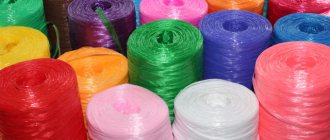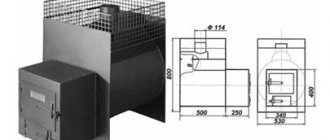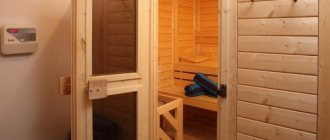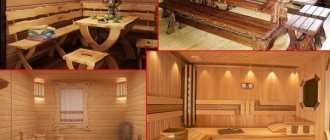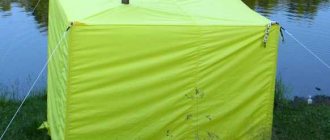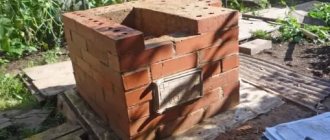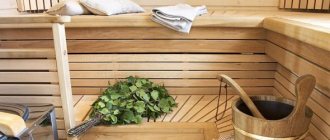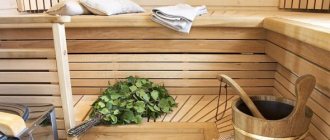After purchasing vegetables and fruits, do not rush to throw away mesh bags. The fact is that food nets are made of quite durable material, which can be useful for making various original crafts. For example, a mesh washcloth for vegetables has long taken root in my home.
It is also important that polymer fibers are not recommended to be thrown away, as they worsen the ecology of the planet. Therefore, it is advisable to find a use for them on the farm.
Today we will tell you how you can make a bath sponge from several meshes.
Choosing your natural washcloth
Washcloths made from plant materials not only perform the main function of caring for the human body, but also provide an additional healing effect. Typically the material used is:
- Bast is the subcortical layer of linden, subject to special steam treatment. Has medium abrasiveness. During use, it releases phytoncides that help treat diseases of the upper respiratory tract.
- Loofah (pictured) is the dried fibrous fruit of a plant from the pumpkin family. Provides a good skin massage.
- Sisal is a fiber made from agave leaves with a woven or knitted structure. Allows you to deeply cleanse the skin, providing excellent peeling and anti-cellulite effect. Increases blood circulation intensity.
- Rami. Thanks to their mesh structure, ramie washcloths help smooth the skin, cleanse pores and improve overall body tone. They also provide a good anti-cellulite effect, gently polishing without scratching the skin.
No less useful and in demand are natural washcloths made from bamboo, jute, rubber, volcanic pumice, and sea sponge.
One of the disadvantages of natural washcloths is their fragility. In the plant environment, pathogenic bacteria quickly multiply, and rotting processes are observed - regardless of the quality of sponge care (heat treatment, washing).
The service life of natural washcloths is short. Compared to their synthetic counterparts, they break down much faster. In addition, as they are used, they quickly become worn out and pathogenic microorganisms are more likely to appear in them.
Doctors say that washcloths made purely from natural materials are more useful, since only they can improve a person’s well-being and mood in a record short time. However, you need to understand that each product has its own pros and cons.
One of the trends in the modern market is that natural products are slowly but surely replacing analogues made from artificial materials. The reason for this is that every year there are more and more people leading a healthy lifestyle.
Disadvantages of washcloths made from natural materials: • noticeably inferior to synthetic products in terms of service life; • dry for a long time; • this is a favorable environment for microorganisms; • require care, which consists of thorough washing, drying in well-ventilated places and treatment with antibacterial agents.
Linen washcloths
The healing properties of flax products were known to our ancestors. After the Second World War, scientists were puzzled by scientific research into the properties of flax. The results of these studies made it possible to confirm folk wisdom regarding flax and its ability to relieve ailments. Linen products stimulate blood circulation and have a beneficial effect on the psyche.
Unfortunately, linen washcloths are a rare “inhabitant” of store shelves.
Loofah sponges
Loofah is a plant belonging to the Cucurbitaceae family. You can often hear the second name of this representative of the plant world – “mad cucumber”. Loofah fruits are very similar to zucchini. If desired, you can make a washcloth from such material at home. When ripe, the inside of the fruit is dry and fibrous. Therefore, to obtain a washcloth, it is enough to dry them, then soak them in water so that the skin softens, and peel the “cucumbers” and remove the pulp from the inner fibers. The washcloth is ready. All that remains is to wash it in soapy water and dry it in the sun.
It is impossible not to note the strength and long service life of such washcloths. Of course, these hygiene accessories have disadvantages: • foam does not form on the surface of the washcloth; • before use, the washcloth is pre-soaked in hot water. This softens the material.
Loofah washcloths are a great purchase for people with oily skin. For people with thin and sensitive skin, a washcloth is not suitable: it is too rough. According to customer reviews, the presentation of washcloths-mittens after several water procedures leaves much to be desired, so it is better to purchase washcloths from a single piece.
Sisal washcloths
Sisal is a coarse, durable material derived from the leaves of the Mexican agave plant. Ropes, twines, mattresses, brushes and washcloths are made from it. Typically, such washcloths are produced in the form of woven mittens that have high peeling properties. Due to their hardness, these washcloths should be used a maximum of twice a week. Sisal washcloths are primarily recommended for people fighting cellulite.
It is better to avoid such a hygiene accessory if you have delicate skin or a large number of moles. These washcloths require pre-soaking, do not hold foam well and are quite expensive, but they exfoliate old cells well and last a long time.
Bast sponges
Not only bast shoes and matting are woven from non-woody wood, but also washcloths, which are considered a bath masterpiece of naturalism, obtained from the lower part of the bark of a young linden tree. There is an opinion that such washcloths are the most beneficial for the skin.
We invite you to familiarize yourself with: Mixture for plastering the stove: composition and proportions of the solution for plastering with your own hands
Don't be afraid that the bast sponge will be too hard. In water, bast softens and gently exfoliates dead cells, deeply cleanses pores, and also releases phytoncides. This version of washcloths does not shine with durability, but this is justified by their cheap price.
Ramie washcloths
In stores you can often see woven washcloths made from ramie - Chinese nettle. In terms of hardness, such washcloths are somewhere between loofah and sisal. A hygiene product made from Chinese nettle, like all hard washcloths, has anti-cellulite and massage properties. Only, unlike other hard washcloths made from natural raw materials, these are gentle on the skin, gently sanding it.
Bristle washcloths
Such accessories are produced in the form of brushes, the material for which is natural bristles. The design feature of such washcloths is a long wooden handle. They provide deep cleansing of the skin from dirt, dust and dead cells. These washcloths are great for massaging problem areas. The massage is performed in a circular motion from the wrists to the shoulders, from the legs to the thighs, bypassing the chest and areas with lymph nodes. A 2-5 minute procedure is sufficient.
Birch bark washcloths
Birch bark is a rich source of the natural antiseptic betulin, which contains many silver ions. The biological role of betulin is to protect the tree from fungal diseases and pests (it is the reason for the white color of the bark of birch trees).
Birch bark washcloths have a good scrubbing effect and help fight orange peel.
But, like all natural products, native Russian washcloths are not cheap, and they are also a rare commodity. Disadvantages of birch bark washcloths: before use, the washcloth should be soaked in boiling water for 10-15 minutes; Dry thoroughly after washing.
♦ How to weave a box and casket from birch bark
♦ Hut on a chicken leg - birch bark craft
Eco-scrubbers
The material for such washcloths is cellulose. Although they are made of wood, they feel soft and elastic to the touch. Outwardly, they are very similar to foam sponges, but differ in their fibrous structure. Washcloths have a lot of advantages: soft; beat the foam well; after drying, they become hard, so they do not collect microbes inside them.
Sea sponges
These are very delicate washcloths, obtained from primitive multicellular organisms, subjected to special processing, after which only a “skeleton” remains of them. Washcloths are sold in solid form, but after soaking they acquire a soft, porous structure. Once dry, the sponges harden again, which prevents germs from growing in them.
You probably won’t find a more delicate natural washcloth. True, the price of sea sponges is steep, and this is even with a short service life. Sponges should be changed every two to three months.
Luffa: types, description and beneficial properties of the plant
The fruits of this culture, without exaggeration, are found in almost every home. Any of us has encountered them at least once, perhaps without knowing what they are. And we will talk about an ordinary washcloth, indispensable in a Russian bath. These slightly harsh, long, elastic products are made from plants of the Pumpkin family - Luffa.
Luffa (loofah, crazy cucumber, edible loofah, loofah gourd)
- An annual plant that, like all pumpkin plants, has a liana-like stem.
- One plant can bear about 8 fruits.
- Luffa is a heat- and light-loving plant that places high demands on soil fertility.
In its country of origin, India, luffa is cultivated as a vegetable crop. In neighboring regions of Southeast Asia it is used to obtain oil, washcloths, durable fiber and as a medicinal plant.
| Interesting! At the beginning of their formation, future loofah fruits look very much like ordinary cucumbers, only much larger in size. In the first few days after formation, they are quite edible, but they do not have a particularly pleasant smell, which, however, disappears during cooking. Luffa fruits are included in the diet of many vegetarians for making soups, frying, stewing, and canned. |
Varieties
There are about 50 types of luffa.
The most famous and in demand:
- cylindrical - the most tender and delicious,
- sharp-ribbed (sharp-toothed) - used largely as a technical crop: for the production of very dense elastic fibers and for the production of washcloths, which are successfully exported to neighboring countries.
I myself also brought such washcloths from Thailand, although I am not a fan of the Russian bath. But I couldn’t resist the temptation, seeing how my compatriots were happily buying them.
Beneficial features
Many experts believe that luffa is a greatly underrated crop. It is grown mostly for commercial purposes. In addition to the well-known bath sponges, luffa is increasingly used in the manufacture of soap, lampshades for floor lamps, vases, glasses, which can be useful as a thermos, because... retain heat perfectly.
Luffa has not found application in official medicine. Nevertheless, Eastern healers with constant success use luffa infusions for venereal diseases, and use the roots to treat dropsy. The healing properties of its young ovaries are indicated as a general tonic, as well as for anemia and anemia.
We invite you to familiarize yourself with Devices for anal
How to fix a mesh washcloth. How to put it back together)
15368 93 9
מאת: Tatyana Glushko People amp; Blogs
Mesh washcloths are not made to last. However, among them there may be both longer-lasting ones and shorter ones. My new bow-shaped washcloth was purchased from the Pyaterochka chain for 51 rubles. This is not a high price, but I still expected that the purchase would serve me well for the required 3 months. To my regret, it completely blossomed within a week of use.
Place your hand inside the net and slide it over your hand like a stocking.
Using your free hand, gather one edge of the mesh into a pile.
Holding the edge, remove the structure and grab the other edge of the mesh with your other hand. You've got an elastic donut.
Continuing to hold opposite edges, turn the donut until it looks like an infinity sign.
Hold the resulting squiggle with one hand. Wrap the second around it with the cord that originally held the washcloth together.
Pass one end of the cord through the other and pull tight.
Spread the edges around the circumference to create a “rose”.
Wash with pleasure!
PS To hold the washcloth tighter, tie another knot. Slide the outer end of the cord under the part that is wound around the core of the washcloth. The result is a loop; insert the end of the cord into it and tighten it.
06 Aug 2021 OLga 211
From plastic bags
A large selection of multi-colored plastic bags, different in texture, is used for knitting washcloths. You can take already used ones, or you can buy new ones. It is better to choose softer ones that do not have handles or ties.
| The bag must be folded several times to one side, leaving approximately 2.5 cm. | |
| The folded part of the package is cut into strips 2.5-3 cm wide, not cutting completely. | |
| The strips are straightened in length. | |
| Then the uncut part is straightened out and the strips are cut diagonally. The cuts go from the cut of the 1st strip to the 2nd, from the cut of the 2nd strip to the 3rd and so on. | |
| It should turn out like this. | |
| The arrow shows the seam of the bag. |
Next, the strips are wound into balls and you can start working. For a washcloth, the size of which is 70*15 cm, approximately 30 medium bags are required. You can knit in any way; you can add elongated loops for strength and looseness.
Useful hand-made: making accessories for the soul and shower with your own hands
Sea sponges
A shower sponge is an intimate personal hygiene device that is found in every home. Lately, high-quality sponges and washcloths that can be used to wash really well have become increasingly rare on sale.
All of them are made of synthetic fabric, and their weaving is sometimes very far from ideal. Therefore, reasonable remarks that any similar bathroom accessory can be bought in a store are not very appropriate here.
If the red thread on your wrist breaks or comes undone
Due to its characteristics, the thread can wear out or break. What to do if your red thread breaks? Kabbalists believe that this happens because the amulet has taken on too much negative energy intended for you. If the red thread breaks, it must be destroyed. This means that now she no longer has any protective forces, but only negativity, which simply has nowhere to go. It is strictly forbidden to throw away the bereginya, which contains part of your soul, otherwise it will become a very powerful weapon against you.
Information from some sources suggests that the red thread must be buried, and when burned, a prayer must be said for the remission of sins. Experienced magicians and practitioners believe that the best option for old amulets is incineration. In the ground, the material will eventually begin to undergo rotting processes, which will have a completely unfavorable effect on your energy field.
The magic of the amulet only works when a person believes in it. When wearing a rope against the evil eye, you need not only to think about your protection, but also to live righteously yourself, not to do harm to others, not to allow reckless thoughts or envy in anyone’s direction. The rope may break under the pressure of your personal internal negative energy. By creating a positive aura around yourself that will fuel the amulet, you will not be afraid of any damage.
When the red thread unties or the amulet on the hand stretches and begins to fall off, this means that it is in effect and reflects negative influence from the outside. The main thing is not to lose your amulet. If the thread does come off your wrist, you need to incinerate the amulet. When the red thread on the wrist is untied, the witches say that the time has come, which means that it has already served its purpose, having taken the main blow, protecting you from misfortune. If the red thread amulet comes undone, then you must burn it after reading a special prayer.
If the red thread is frayed or torn, there is no need to despair, this is considered a good sign. All negative energy has left you forever. You should not tie it again, the old one must be destroyed and a new one put on. If the red thread tied to the fulfillment of a wish is untied, this means approaching your cherished goal. As you get closer to what you want, one knot will be untied.
Soft or hard?
In the refrigerator and on the brush. Where do bacteria most often accumulate?
Bast washcloths are thin strips of bast that can be tied into a bun or sewn onto a fabric base. The bast itself is made from the inner bark of linden or other deciduous trees. Bast sponges are good for baths, but they are not recommended for use in ordinary bathrooms: the material crumbles and can clog the drain.
Suitable for: bast is a fairly hard material, so it can be used for deep cleansing of the skin. The washcloth can be softened a little by dipping it in boiling water for 10-15 minutes before use.
It is better not to use if you have delicate skin or if you prefer to shower with foam - the bast loofah does not foam well.
We suggest you read: How to decorate walls in a bathhouse
Loofah (sometimes spelled luffa) has recently become a popular material for bath accessories. It is a dried vine fruit that has been freed from the skin and seeds. Loofah can be found in the form of a roll, cut into pieces or “packed” in soap.
Who is it suitable for: the loofah is quite hard, so it can be used for peeling and anti-cellulite massage during water treatments.
It is better not to use for people with delicate skin and those who want to maintain a tan longer - a hard washcloth quickly erases the top layer of skin.
Linen washcloths are famous for their durability, ability to absorb water well and lather well. Items for water procedures can be knitted from linen threads or sewn from linen. In the second case, a piece of soap is sometimes placed inside the washcloth.
Suitable for: lovers of foam bathing and allergy sufferers.
It is better not to use for people with particularly delicate skin.
Sisal fiber is also used to weave washcloths, which are quite stiff, but have enviable strength.
Suitable for: those who want to get rid of dead skin on their elbows and heels.
It is better not to use if you have sensitive skin.
Bristle brushes of different sizes and different hardness are suitable for the whole body: with an accessory on a long handle you can scrub your back, small brushes will clean your fingers and feet.
Suitable for: Those who like a good back rub
It is better not to use for those with sensitive skin, or choose especially soft bristles.
Toys will help to accustom your child to water procedures.
For sensitive and problem skin, you should not choose hard washcloths made of sisal, jute, or coarsely knitted washcloths made of polypropylene tape. They will irritate the skin and provoke excessive secretion of sebum.
How to choose threads?
Threads for washcloths are usually used natural or synthetic, it all depends on the preferences of the housewife. Although natural materials have a positive effect on the skin, they have a number of disadvantages. They are short-lived, susceptible to rotting and mold, and therefore require additional disinfection and drying. Synthetics do not rot at all, are easy to clean and dry well. These fibers have varying degrees of stiffness.
The quality of a knitted washcloth depends on the correct selection of threads and hook size. You can waste time and material, but knit an item that is unsuitable for washing. In many cases, you can use the hook size that is listed on the yarn label or pattern. In work, they usually use model No. 4 or No. 5. Knitting with a thinner tool looks neater, but the product itself comes out tough.
Let's take a closer look at each type of thread. Among the natural fibers suitable for knitting washcloths are:
- Hemp, made from hemp fibers.
- Jute is made from textile fiber. It makes hard products.
- Bast is rich in phytoncides, but is short-lived.
- Cotton is not very practical for washcloths.
- Wool is often used for washcloths.
- Sisal is obtained from the fibers of agave leaves and is used mainly for washcloths. It has good foaming properties and effectively cleanses the skin, providing a scrub effect.
- Flax fibers are soft, durable and dry quickly, and their qualities only increase over time. Such washcloths have numerous therapeutic and health effects on the body.
Knowing the disadvantages of natural materials, housewives still prefer synthetic fibers:
A little history and purpose
It is not known for certain when the first devices appeared to help cleanse the skin, but already in references in Babylon and Ancient Greece there is information about the first washcloths. Wealthy people used wood or bronze to wash their skin, while poor people used bunches of plants or sand.
Now, a washcloth is already an absolutely necessary household item for every person. Beautifully designed, of different sizes, colors and purposes, they decorate the bathroom and are indispensable assistants in the bathroom.
A washcloth can be made from any available material: natural cotton or chintz, using old terry towels, woven from burlap, and for those who are not looking for easy ways - knitted.
Burlap washcloth
If you don’t know how to knit or don’t want to, you can make a beautiful washcloth with your own hands using burlap, for this you will need: burlap, foam rubber or sponge, gauze, soap and elastic, and also a piece of cotton fabric.
From burlap you need to cut two identical rectangles slightly larger than your palm, and the same ones for the gauze lining. A holder for a bath accessory is made using an elastic band, assembled like an accordion and covered with fabric. One end is secured in the middle of a burlap rectangle, and the other is sewn to the side.
Next, the burlap is sewn together to form a bag and pieces of soap and a sponge are placed in it to create foam; dried lavender or mint can be added for scent. The washcloth needs to be sewn up. It is ready to use. When the soap in it stops foaming, you will need to rip it open and pour in a new portion.
From pumpkin and tights
Today there are quite a lot of materials for creating washcloths with your own hands. Depending on whether you want to have this bath attribute made from natural or artificial threads, not only the price of the finished product depends, but also its appearance. As a rule, yarn from natural or artificial materials is used to weave washcloths. Less commonly, natural materials that only need to be cut into cubes before use. So, a striking example of this is the loofah (loofah, luffa).
This is a herbaceous plant from the pumpkin family, which, when ripe and dried, is a natural loofah - you just need to remove a layer of hard peel. Initially, luffa was widespread in the countries of the African continent and in some regions of Asia, but now it can be grown even in the southern regions of our country.
Polypropylene washcloth
To knit such a bath “helper”, it is enough to purchase the appropriate threads and a hook size 5-6 with a round head. Initially, you need to knit a chain of loops 20 cm long and connect them into a ring.
Next, you need to knit the main fluffy part of the washcloth using the “DC” method and finish with several rows of “SC”, and at the end knit the handles. This way you can knit a washcloth from any material.
These artificial materials, from which various shower sponges are most often knitted, are convenient because they are quite easy to work with. The thread does not fluff for obvious reasons and does not get tangled, so it is easy to handle both with crochet and knitting needles. Another positive factor of polypropylene yarn is the wide range of colors.
You need to knit from polypropylene with knitting needles and crochet no finer than number four or even number five. This thread is quite stiff, and therefore it is advisable not to pull it very tightly, since a washcloth that is too coarse is not suitable for use. Moreover, you need to be especially scrupulous about this issue if you plan to knit a washcloth for a child.
Polypropylene makes beautiful washcloths in the shape of a hedgehog toy. To do this, you will need threads of two different colors: darker - to create its needles and lighter - for the muzzle. You need to crochet a hedgehog with elongated loops as follows.
- Cast on 20 cm of loops with a dark thread, connect them into a ring and knit two rows with single crochets.
- Make several rows of elongated loops: pull out the loops two to three centimeters long and remove them from the hook, knitting the loops through one stitch.
- Knit with elongated loops 10 centimeters in height.
- Next, use light threads to knit the cone-shaped face of the animal.
- Knit according to this pattern - two single crochets, then skip the next loop and two double crochets again - so that the knitting begins to taper.
- Knit in this way until all the loops come together.
- Make the nose and eyes of the animal from black thread - and the washcloth is ready.
In addition, you can make a knitted washcloth in the shape of a mitten from polypropylene thread, which will be not only beautiful, but also a convenient bath accessory. Two identical parts of the product are knitted. First of all, you need to crochet 20 loops and knit five rows with single crochets. Then, to knit a finger at the end of the row, you should cast on eight air loops and tie them with double crochets.
Return to the main fabric and knit five more rows with single crochets, then begin to cut the loops, rounding the top of the mitten. To do this, do not knit one stitch from each edge of the knitting until the mitten is completely rounded. Complete the second part of the product in the same way and sew the finished halves together.
We suggest you read: How to assemble a log house yourself
Loofah with filler
You can make a more elegant sponge from large and fine mesh.
You will need
- two types of mesh - large and fine. A large mesh can be taken from potatoes or fruits, and a small mesh can be taken from sweets, garlic, or old ribbons from a bow or tulle
- thread and needle
- scissors
- For the base of the washcloth, we use a large mesh (it is advisable to wash it before use). Cut a square piece 15 x 15 cm and bend it in half to form a pocket.
- Fill the pocket with tulle or fine mesh and sew up the open end. Then pass the thread through the edge of the mesh, pull it out and secure it with a couple of knots. The result should be a “bag”.
- Now let's give the sponge a finished look. Pass the needle and thread through the center of the washcloth, leaving a 10cm tail, then do the same in the opposite direction.
- Repeat this several times until a depression is formed in the middle of the sponge. At the end, secure the ends of the thread and trim off the excess.
- Now rinse the sponge thoroughly in hot water and soap to remove any remaining odors and dirt.
As you can see, nothing is complicated. Give this simple dish sponge a try and see if it's worth the effort. Even if the savings are small at first glance, our handmade product will pay off in the long run: it can be used for 2 or 3 months. Take this kitchen life hack and share your impressions with us.
Results
If you look at examples of photos of do-it-yourself washcloths in books, brochures, craft magazines or on the Internet, you will see what a variety of these bath items there are. In addition to the original accessory, spending a minimum of time and effort, you will receive a real decoration for the bathroom, an indispensable cleanser suitable for your skin and save money.
Such washcloths can be given as a gift or an addition to a gift, or they can also be sewn for children in the form of various animals or cartoon characters. The child will be more willing to bathe with such a gift.
Threads come in different thicknesses. The thicker the thread, the tougher the finished washcloth will be. Select threads of such thickness that it is convenient to use them for crocheting No. 3-4. Although the most delicate and soft washcloths are crocheted No. 2, i.e. thin threads. Some people like washcloths that are harder and denser, while others like them softer.
Buy bright threads to match your bath accessories. For children, it is better to knit a washcloth from thin threads in the shape of a mitten or a funny animal.
Before the first use, be sure to keep the washcloth in boiling water for 5-7 minutes, the washcloth becomes pleasant to the body and lathers well.
A washcloth with elongated polypropylene loops can be knitted in the form of a pipe in a circle. It is convenient to insert foam rubber into such a washcloth.
- You can knit a flat rectangular washcloth according to the usual pattern using single crochets (only every third row is knitted with elongated loops):
- The crocheted washcloth can be oval-shaped (in this case, every third row is also knitted with elongated loops):
- A washcloth can be crocheted in the form of a mitten:
- Round washcloth (do not forget to knit every 2 or 3 rows with elongated loops):
- A crocheted washcloth for a child can be crocheted in the shape of any toy.
There is one more nuance: the longer the loops, the softer the washcloth.
If you have never knitted with elongated loops, then you should first try to knit a sample from simple threads in order to practice and work out the tightness of the knitting. The fact is that you need to knit tightly with long loops, i.e. Tighten each loop with columns so that the fabric is not loose. It will be especially difficult for beginners to immediately knit elongated loops from polypropylene threads.
Options for knitting washcloths for beginners
Even a person who does not have much knowledge and experience in this type of needlework can knit a product with a hook. Beginners can try their hand at knitting a single-sided washcloth. In this version, they will hone their skills in order to move on to more complex ones in the future. The product is knitted with elongated loops, and the furry part will be on only one side. This element is simple to perform: you need to pull out loops a couple of centimeters long, as indicated in the diagram presented.
As a rule, such washcloths for beginners are made in a square shape to simplify the task as much as possible. The simplest option: cast on as many air loops as the width you want the product to be, and knit a couple of rows with single crochets. Then perform a row with elongated loops and a row with single crochets. Repeat this alternation until the length of the washcloth you desire. Also knit the last two rows with single crochets.
From one end of the square, knit enough chain stitches so that the chain reaches the other end of the square and hangs slightly. Secure the chain at the other end and cross it with single crochets. If you wish, you can knit two identical fabrics and sew them together by placing a piece of foam inside.
Knitting pattern for a round washcloth
The advantage of single-sided washcloths is that they dry faster after bath procedures. They also use a simple pattern, such as elongated loops, double and single crochets, and puffy stitches. All this is clearly visible in the finished product. And, besides, more complex patterns will simply not lather well and then take a long time to dry.
To make knitted washcloths, it is better to resort to the simplest elements possible. If we talk about material for crocheted accessories, it is best to take natural threads. For example, the following threads have proven themselves well in work and further use in the product:
They are quite harsh, which is good for thoroughly cleansing the body, and have a lot of positive health properties. You can also create a version of a bath sponge in the shape of a pipe. To do this, you also need to master the technique of making elongated loops.
Crochet washcloth video tutorials
Crochet washcloth. Master class from Noskova Nadezhda
The washcloth is crocheted in the round from elongated loops. Polypropylene threads.
Crocheted washcloth. Oksana's work
You will need yarn for knitting washcloths and a size 4 hook.
The washcloth is crocheted No. 2; it took half a skein of thread.
This washcloth is crocheted from propylene thread in 2 folds, with crochet number 5. It is knitted equally on both sides, with a “Fringe” pattern or elongated loops.
A washcloth-mitten, just like a regular washcloth, is knitted simply: 1 row of single crochets, 1 row of elongated loops.
Materials: – polypropylene threads of different colors; – crochet hook (select the size depending on the desired density of the washcloth - the smaller the number, the denser the product will be, and vice versa).
Author Irina Kachukova. For knitting you will need: yarn “Housewife - a needlewoman for the soul and soul” 50g, 100% polyamide, package 10x50g and a hook.
The knitting pattern is very simple:
- 3 rows of single crochets
- 3 rows of lush columns
How to knit lush columns, see the diagram below in the article.
You will need: polypropylene threads of 2 colors. hook No. 3 or No. 4, needle with a wide eye. The size of the finished washcloth is 14*21 cm.
Tags: washcloth, back, mesh, collect, diagram
« Previous entry
To watch online, click on the video ⤵
How to assemble a washcloth from a mesh. How to assemble a washcloth from a grid. More details
How to put the washcloth (bow) back together. More details
How to restore the Sponge – How to assemble Bath Sponge from a mesh / Life hacks Read more
Quickly made washcloth. A washcloth for a soldier. More details
HOW TO MAKE A WASTE FROM A PLASTIC BOTTLE. DIY DISH SCOOT More details
WATCH! HOW TO UNTOTATE A DOLL'S HAIR? More details
Washcloths ?? “Women's joy” and ?✈️ “Male happiness”. Family? business of the 90s (washcloth). More details
Converting a muffler into a direct-flow muffler, second life for an old can [PVS] More details
